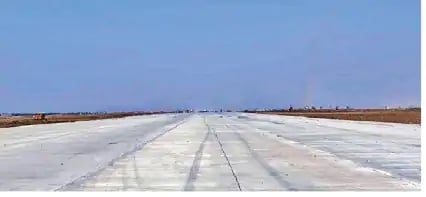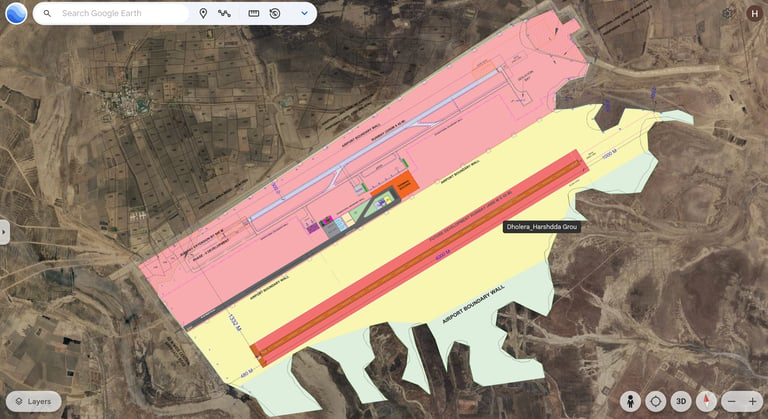Dholera International Airport: A New Era of Connectivity and Development in Gujarat
The fact that the Prime Minister's Office is directly monitoring the progress and that the terminal and cargo handling contracts are finalized shows how strategically important this project is.
PROGRESS INSIGHTS
4/8/20255 min read


The infrastructural landscape of Gujarat is on the brink of a transformative leap as preparations are in full swing to inaugurate the Dholera International Airport within the next six months. This ambitious project, which has been in the pipeline for several years, is finally gaining rapid momentum, reflecting the government’s commitment to turning the Dholera Special Investment Region (SIR) into a global business and industrial hub.
With the runway construction already 70% complete and a trial run scheduled for June 2025, the Dholera International Airport is poised to become a cornerstone of economic growth, enhanced connectivity, and regional development. Here's an in-depth look at what this development means for Gujarat, and India at large.
The Strategic Importance of Dholera International Airport
Located between Bhavnagar and Ahmedabad, Dholera has been envisioned as India’s first smart and greenfield industrial city under the Delhi-Mumbai Industrial Corridor (DMIC) project. The Dholera SIR is designed to be a world-class destination for manufacturing and industrial investment, and the airport is a critical component of this vision.
Dholera International Airport will not only serve the passenger needs of the region but will also function as a key logistics and cargo hub. Its proximity to major highways, the upcoming Ahmedabad-Dholera Expressway, and future railway connections make it a strategic choice for air cargo movement, especially for industrial goods and exports.
Project Status: Construction and Trial Run
The on-ground construction work is progressing at a brisk pace. According to recent updates, 70% of the 3.2-kilometer runway — capable of accommodating large aircraft like Boeing 747s — has been completed. The airport is being developed in phases over an area of more than 1,427 hectares, and the first phase is expected to handle close to 1.2 million passengers annually.
A trial run is scheduled for June 2025, which will be a key milestone in evaluating the airport's readiness. Once the testing phase is complete, the airport is expected to be fully operational in the following months. Official notifications regarding the same are anticipated soon.
Government Support and National Priority
One of the major indicators of the project's significance is the direct monitoring by the Prime Minister’s Office (PMO). The PMO’s involvement underlines how central this project is to the broader economic vision for India, particularly in the area of regional connectivity and smart city development.
Additionally, the tender process for terminal and cargo handling operations has been completed, ensuring that critical operational infrastructure is in place before the launch. These steps signify that not only is the airport nearing completion, but it is also being equipped for seamless functionality from day one.
Impact on Dholera SIR and Regional Development
The operationalization of Dholera International Airport will act as a massive catalyst for the growth of the Dholera SIR. Envisioned as a futuristic smart city with robust digital and physical infrastructure, Dholera SIR has already attracted attention from global investors and corporations looking to establish manufacturing units, logistics centers, and R&D hubs.
The airport will offer a direct channel for international trade, business travel, and air cargo, which will enhance the competitiveness of industries operating in the region. Furthermore, it will significantly reduce the travel time and logistical costs for businesses, making Dholera an even more attractive destination for investment.
Boost to Real Estate and Land Value
The anticipation of the airport’s opening has already started reflecting in the local real estate markets. Land prices in and around Dholera have seen consistent appreciation over the past few years, and the upcoming airport is expected to trigger a new wave of interest from developers, investors, and businesses.
Large parcels of land, especially those near the airport and the activation area of the SIR, are being eyed for industrial parks, logistics hubs, warehousing, and commercial developments. Residential projects are also expected to flourish, particularly as professionals begin relocating for employment opportunities once the region becomes fully operational.
Creating Employment and Economic Opportunities
The Dholera International Airport will generate thousands of direct and indirect job opportunities. From construction workers and engineers during the development phase to airport staff, airline crew, cargo handlers, logistics managers, and hospitality professionals post-launch — the employment potential is enormous.
Moreover, the airport will encourage the setting up of ancillary services such as hotels, restaurants, transport providers, and more, further boosting the local economy. In the long term, it will foster an ecosystem of economic activity that aligns with the government's "Make in India" and "Atmanirbhar Bharat" initiatives.
Enhancing Gujarat’s Connectivity and Global Positioning
Gujarat is already known for its robust industrial base, excellent road network, and investor-friendly policies. The addition of a state-of-the-art international airport in Dholera will further elevate the state’s connectivity, not just within India but also with global markets.
It will complement existing airports in Ahmedabad, Vadodara, and Bhavnagar, providing additional capacity and reducing air traffic congestion. For international businesses with a presence in Gujarat or looking to expand, the Dholera airport will offer a more direct and efficient route for goods and personnel.
Integration with Other Infrastructure Projects
The Dholera International Airport is not an isolated development. It is part of a much larger network of infrastructural initiatives that include:
Ahmedabad-Dholera Expressway: A high-speed expressway that will dramatically cut travel time between the city and the airport.
DFC (Dedicated Freight Corridor): Enhancing logistics and rail connectivity to the north and western ports.
Metro connectivity (future plan): Providing seamless urban transport within the Dholera SIR.
Together, these projects will create a multi-modal transport hub that integrates air, road, and rail seamlessly — positioning Dholera as a model for future urban development.
Environmental and Technological Edge
What sets Dholera apart from traditional industrial zones is its emphasis on sustainability and technology. The airport is being designed with eco-friendly systems, energy-efficient architecture, and smart monitoring tools. Solar energy integration, rainwater harvesting, and green landscaping are part of the design philosophy.
Additionally, the airport is expected to incorporate smart management systems for traffic control, baggage handling, and cargo tracking — in line with the smart city mission that defines the Dholera SIR.
What Lies Ahead
As Dholera International Airport moves closer to reality, the excitement among stakeholders — from government bodies and investors to local communities and industrialists — continues to grow. The next six months will be crucial in finalizing construction, running tests, and ensuring all logistics and regulatory approvals are in place.
Once operational, the airport will not just serve as a point of transit — it will be a gateway to a new industrial age in India. With Dholera SIR poised to become a global manufacturing and innovation hub, the airport will play a central role in enabling this vision.
Conclusion
The countdown has begun. With 70% of the runway completed, contracts in place, and the government fully backing the project, Dholera International Airport is no longer a distant dream — it's a fast-approaching reality.
For investors, developers, entrepreneurs, and job seekers, now is the time to pay close attention. The next chapter of Gujarat’s development story is being written in Dholera, and the airport will be the runway from which the region — and perhaps the nation — will take off into a new era of progress and prosperity.


